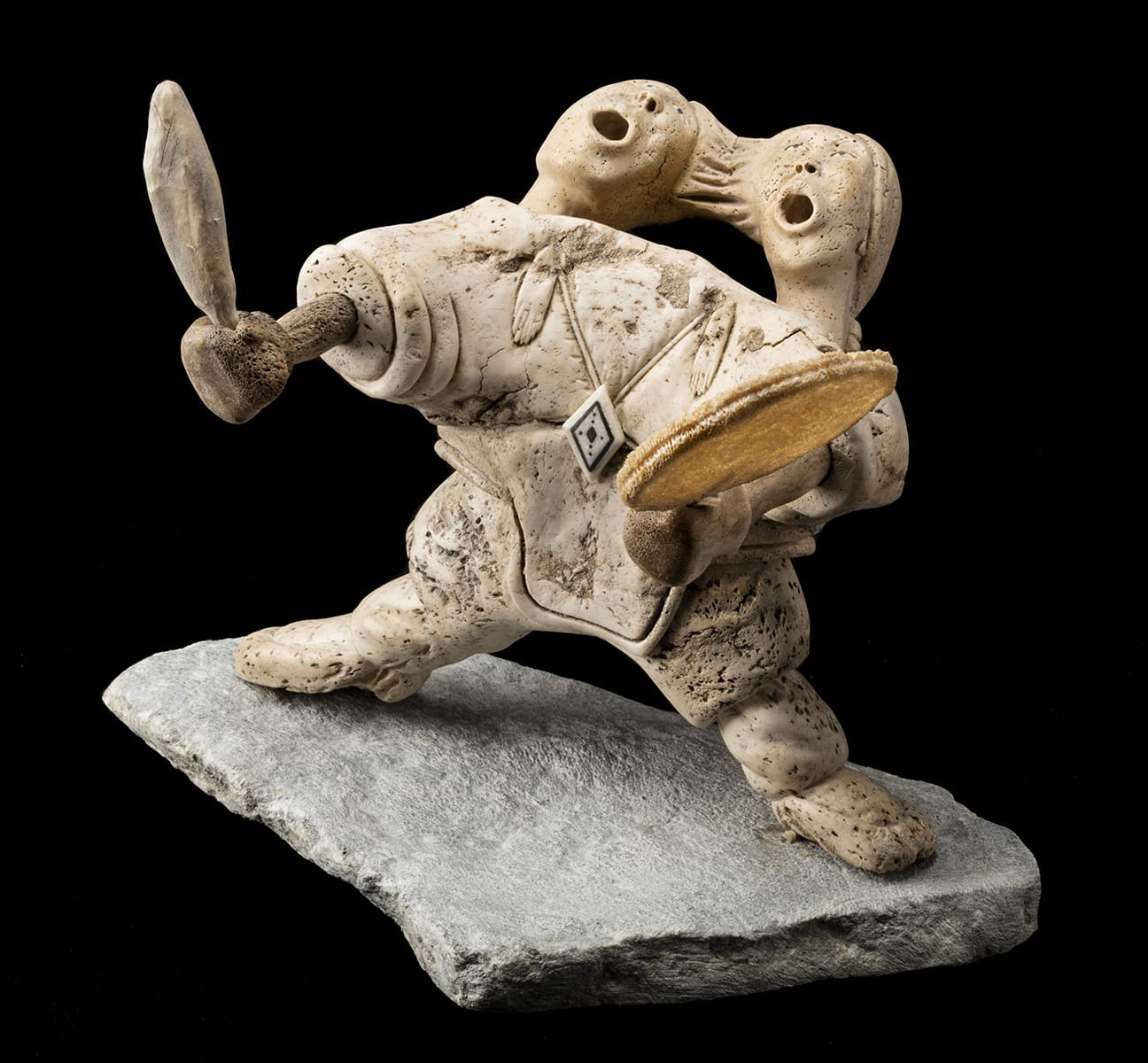-
Artworks
MANASIE AKPALIAPIK (1955-) IKPIARJUK (ARCTIC BAY) / TORONTO / OTTAWA
Drum Dancer, 1989whalebone, antler, ivory, black inlay, and stone, 12 x 14.5 x 11.75 in (30.5 x 36.8 x 29.8 cm)
signed and dated, "ᒪᓇᓯ/ ᐊᐸᓕᐊᐱ / 89".
LOT 7
ESTIMATE: $8,000 — $12,000
PRICE REALIZED: $26,400.00Further images
This extraordinary sculpture was carved at the height of Manasie’s creative powers, almost ten years after his move to southern Canada after the tragic death of his wife and two...This extraordinary sculpture was carved at the height of Manasie’s creative powers, almost ten years after his move to southern Canada after the tragic death of his wife and two small children, and a couple of years after a ten-month “sabbatical” back in the artist’s home community of Arctic Bay, during which time Manasie learned kayak-making and drum dancing.
We would like to quote from George Swinton’s review of the Winnipeg Art Gallery solo exhibition of Manasie’s sculpture in the Spring 1991 issue of IAQ. George Swinton’s always incisive commentaries are particularly interesting with regard to this work. Swinton recognized Manasie as an Inumarik (“truly an Inuk”) yet he insisted that Manasie be discussed as a sculptor first, one who just happened to be an Inuk. He wanted us to appreciate Manasie’s art through its “visual form” rather than its “verbal content.”
“…Drum Dancer…is a remarkable tour de force. The powers of the drum dance are transmitted through the ecstatic movement of the drummer/dancer/singer. In a wild frenzy of exuberant and prodigious shapes, with mouth(s) and eyes opened wide, the (doubled) head sways eloquently to and fro in rhythm with the drum beat. This sculptural movement is repeated by the eyes, mouths and the widely extended drum and drum stick and by the even more widely spread short, strong legs. The incredibly massive body stands in stark and ingenious contrast, further accentuated by the incisive, geometric shapes of the amautik clasp and straps. This is what I mean by [Manasie’s] form speaking so directly and effectively” (p. 44).
It should be kept in mind that Manasie’s art was considered almost as exciting in 1991 as Karoo Ashevak’s sculpture had been in the early 1970s. While Judas Ullulaq took over Karoo’s mantle as the leading Kitikmeot sculptor, it was Manasie Akpaliapik who captured the essence of Karoo’s spirit with his modernist vision, his inventive use of whale bone, and his brilliant technical skill. Although smaller in scale than many of Manasie’s bone compositions, Drum Dancer is surely one of the artist’s masterpieces.
References: See George Swinton’s analysis of Manasie’s sculpture in “The Art of Manasie Akpaliapik: A Review Essay” in Inuit Art Quarterly (Spring 1991:42-45). Drum Dancer is reminiscent of the double faces seen on both sides of Manasie’s contemporaneous masterpiece Respecting the Circle (1989) in the Sarick Collection at the AGO; see Ingo Hessel, Inuit Art: An Introduction (Vancouver: Douglas & McIntyre, 1998), figs. 56 A and B; also illustrated in Gerald McMaster, editor, Inuit Modern: The Samuel and Esther Sarick Collection (Toronto: Art Gallery of Ontario, 2010), p. 74, and in Swinton (1992), fig. 828. For several other examples of Manasie’s sculpture see Harold Seidelman and James Turner, The Inuit Imagination: Arctic Myth and Sculpture (Toronto: McClelland & Stewart, 1993).
Provenance
Images Art Gallery, Toronto;
Private Collection, Toronto.Exhibitions
Winnipeg, Winnipeg Art Gallery, Manasie: The Art of Manasie Akpaliapik, August-November 1990.
Literature
Darlene Wight, Manasie: The Art of Manasie Akpaliapik (Winnipeg: Winnipeg Art Gallery, 1990), fig. 2;
George Swinton, “The Art of Manasie Akpaliapik: A Review Essay” in Inuit Art Quarterly ,Spring 1991,, p. 42. George Swinton, Sculpture of the Inuit (Toronto: McClelland & Stewart, 1992 – new edition only), fig. 907.
Join our mailing list
* denotes required fields
We will process the personal data you have supplied in accordance with our privacy policy (available on request). You can unsubscribe or change your preferences at any time by clicking the link in our emails.














